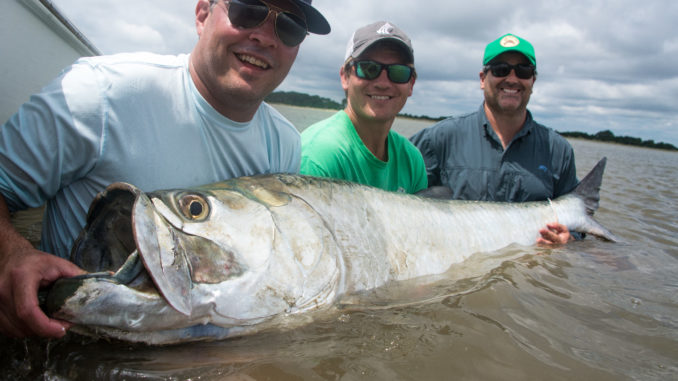
Find schools of baitfish, and you’re on the way to tarpon heaven
While South Carolina’s tarpon fishery may not compare to the Florida Keys, its popularity is increasing every year.
Actually, the tarpon that Key West anglers catch are some of the same that show up along South Carolina’s coast, migrating northward to spend the summer in cooler water. The first real push begins in July, and they arrive ready to eat anything they can find.
The waters around Georgetown, S.C. — encompassing everything from North Inlet at Debordieu Island south to Cape Romain — are practically a buffet table, and tarpon return every year, taking advantage of huge schools of menhaden and mullet that utilize the area.
Jordan Pate of Carolina Guide Service is one of only a few area captains who specifically target tarpon, a fish he considers one of his specialties.
“July can be a good time. I typically start to see a few good pushes of tarpon in early July,” said Pate (843-608-8307). “Many of our July tarpon are still in migration mode, so they can be here one day and gone the next.
“The fishing becomes more consistent towards the end of the month.”
When they do arrive, tarpon usually show up with a whale of an appetite, which helps anglers find out where to find these fish.
“Just like any gamefish, the key to locating tarpon is to locate the baitfish, which happens to be menhaden this time of year,” he said.
During the summer, menhaden congregate along the beachfront or between the Intracoastal Waterway and the inlets. Pate likes to run the beachfront, looking for large congregations of bait.
“The tarpon will find the bait, no matter where it is, and if I see tarpon surfacing in the bait, we will stop and fish,” he said.
But the tarpon will also set up on current breaks, ledges and current rips in ambush mode to snag an easy meal. If Pate doesn’t see any fish, he will set up on ledges adjacent to 20- to 30-foot water or other places where a large fish would typically ambush a school of menhaden.
In places along the beach where a lot of menhaden pods present, he will slow-troll live bait.
“More often than not, I am slow-trolling live baits in places where I have seen tarpon lately or anchored down,” he said.
When slow-trolling or anchored, Pate will have a pitch rod rigged with a D.O.A. Swimming mullet or an 8-inch Hogy jig, because a tarpon can show up without any notice, and they aren’t afraid to take an artificial lure when they are ready to eat.
Tarpon will travel long distances in a short time, and the fish that show up along the South Carolina coast are adults with more than 10 years under their belts, very educated to dangers. Pate offsets these inhibitions with a stealthy approach.
“Tarpon are very sensitive to boat traffic, so minimizing boat noise can make the difference between seeing a fish and getting a bite,” he said.
While anglers may not get the volume of bites that anglers do in Key West during the spring migration, Georgetown anglers can have a good opportunity at hooking with one of these beasts if they play their cards right.

